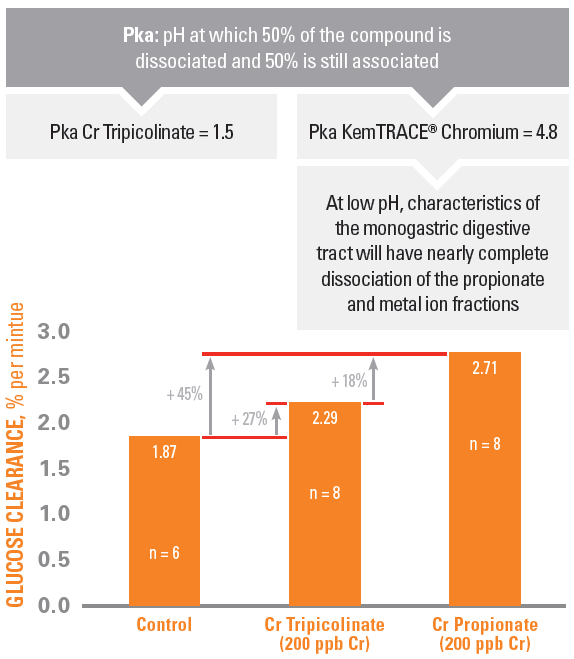You are viewing United States
- United States
- Canada
- Mexico
- South America
- EMENA
- Sub-Saharan Africa
- Russia
- South Asia
- Asia Pacific
- China
- Global
Choose Your Location:
- United States
- Canada
- Mexico
Popular Searches
- Animal Nutrition & Health
- KemTRACE® Chromium
- KemTRACE® Chromium for Swine
- Chromium Propionate vs. Chromium Picolinate
Chromium Propionate vs. Chromium Picolinate
Did you know that different forms of chromium have different modes of action, and varying levels of efficacy? Are you utilizng the right chromium for your operation?
Chromium propionate, the active molecule in KemTRACE® Chromium, results in superior dissolution in the digestive tract when compared to chromium picolinate. This superior dissolution leads to substantially more chromium available for absorption in the small intestine, which is key for greater efficacy. Improved absorption of chromium enhances the metabolic benefits of chromium, such as increasing glucose clearance from the blood to various tissues and organs, including muscles. Increased glucose clearance amplifies energy available for the pig to utilize and may optimize overall performance, based on the animal's hierarchy of needs.

Chromium propionate has a Pka (the unit dissociation equilibrium) of 4.8, compared to chromium picolinate at 1.5. This results in a higher availability of chromium for absorption within the intestines.

Higher absorption ensures more chromium is available in a form the animal can use for optimal benefits.

Blood glucose clearance provides further evidence that chromium propionate delivers a higher value than chromium picolinate.
Ready to see the data?
In an insulin challenge study, pigs were given 0.1 IU porcine insulin/kg of body weight to determine the bioavailability and resulting insulin sensitivity (Figure 1). Pigs fed chromium propionate showed a 45% increase of glucose clearance compared to the control and an 18% increase compared to chromium propionate — providing more glucose for the pig to use.

Figure 1. Effect of dietary chromium source on glucose kinetics during an intravenous insulin challenge test (IVICT) in growing barrows (0.1 IU porcine insulin/kg BW)3
Resources
References
1Unpublished data on file at Kemin Industries, 2007.
2Matthews, J. O., et al. (2001). Effect of chromium picolinate and chromium propionate on glucose and insulin kinetics of growing barrows and on growth and carcass traits of growing-finishing barrows. Journal of Animal Science. 79.
3Matthews, J.O., L. L. Southern, J. M. Fernandez, J. E. Pontif, T. D. Bidner, and R. L. Odgaard. (2001). Effect of chromium picolinate and chromium propionate on glucose and insulin kinetics of growing barrows and on growth and carcass traits of growing-finishing barrows. Journal of Animal Science. 79:2172-2178.
Have a Question?
If you have a question about our products or services, or just want more information, fill out the form below and someone on our team will be in contact with you.
- California Residents
- California Supply Chain Act
- Canada Forced Labor and Child Labor Report
- Email Disclaimer
- GDPR Personal Data Addendum
- General Terms & Conditions for Vendors
- Global Environmental Policy Statement
- Indirect Cost Estimates
- Kemin Terms & Conditions
- Modern Slavery Act Transparency Statement
- Privacy Policy
- Sitemap
- Change Cookie Consent
- Animal Welfare Statement
© Kemin Industries, Inc. and its group of companies All rights reserved. ® ™ Trademarks of Kemin Industries, Inc., USA
Certain statements may not be applicable in all geographical regions. Product labeling and associated claims may differ based upon government requirements.



